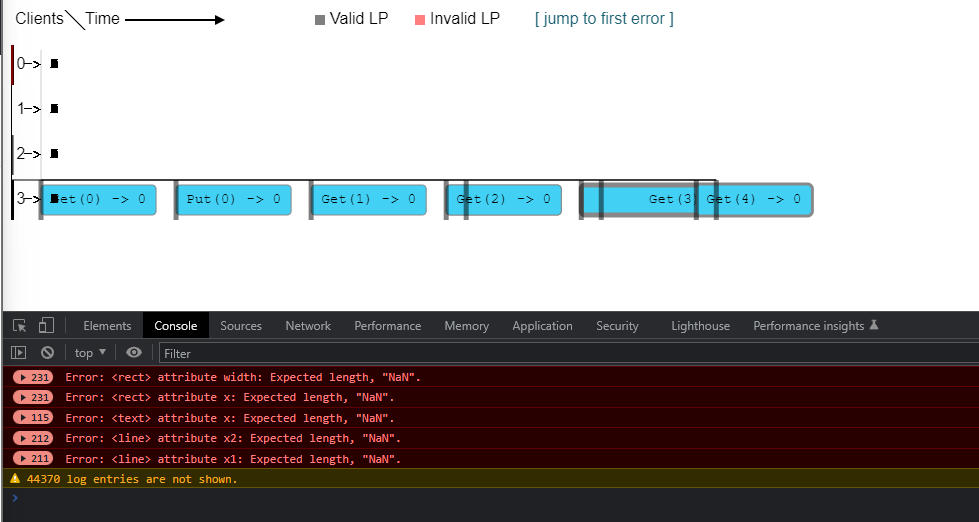The issue is with the model. (re-attaching your original model.go here in case anyone wants to refer to it in the future).
(hidden, click to expand)
```go package rwlock import ( "fmt" "github.com/anishathalye/porcupine" "reflect" ) const ( GetOp = iota PutOp = iota DelOp = iota ) type Input struct { Operation uint8 Key int Val int } type Output struct { Key int Val int Found bool } type State struct { state map[int]int } var Model = porcupine.Model{ Init: func() interface{} { return State{ state: map[int]int{}, } }, Step: func(state interface{}, input interface{}, output interface{}) (bool, interface{}) { s := state.(State) i := input.(Input) o := output.(Output) stateVal, found := s.state[i.Key] switch i.Operation { case GetOp: if !o.Found { return !found, s } else if stateVal == o.Val { return true, s } break case PutOp: s.state[i.Key] = i.Val return true, s case DelOp: delete(s.state, i.Key) return true, s } return false, s }, Equal: func(a, b interface{}) bool { return reflect.DeepEqual(a, b) }, DescribeOperation: func(input interface{}, output interface{}) string { i := input.(Input) o := output.(Output) opName := "" switch i.Operation { case GetOp: opName = "Get" break case PutOp: opName = "Put" break case DelOp: opName = "Del" break } return fmt.Sprintf("%s(%d) -> %d", opName, i.Key, o.Val) }, DescribeState: func(state interface{}) string { s := state.(State) return fmt.Sprintf("%v", s.state) }, } ```The problem is that Model.Step violates the contract that Step should be a pure function. (This isn't explained clearly in the docs, so I'll work on improving the documentation on this.)
Fixing that:
diff --git i/rwlock/model.go w/rwlock/model.go
index 29ca178..6eba91c 100644
--- i/rwlock/model.go
+++ w/rwlock/model.go
@@ -28,6 +28,15 @@ type State struct {
state map[int]int
}
+func (st State) Clone() State {
+ var st2 State
+ st2.state = make(map[int]int)
+ for k, v := range st.state {
+ st2.state[k] = v
+ }
+ return st2
+}
+
var Model = porcupine.Model{
Init: func() interface{} {
return State{
@@ -35,7 +44,7 @@ var Model = porcupine.Model{
}
},
Step: func(state interface{}, input interface{}, output interface{}) (bool, interface{}) {
- s := state.(State)
+ s := state.(State).Clone()
i := input.(Input)
o := output.(Output)Now, it seems to pass:
$ go test -v
=== RUN TestHappyPath
--- PASS: TestHappyPath (0.00s)
=== RUN TestMultiGoroutines
--- PASS: TestMultiGoroutines (3.34s)
PASS
ok github.com/anishathalye/porcupine/rwlock 3.470sI'm guessing that the borked visualization was due to the buggy Model.Step, but if you're still seeing buggy visualizations, please let me know, I would like to debug it.
Hey @anishathalye,
Thanks for the library, we're making pretty heavy use of this now in etcd and I spent the day to play around with it and check a toy database of mine.
While doing that, I came across an odd issue with
sync.RWMutexwhich guards the three main operations (Get with ReadLock and Put+Delete with a WriteLock).From sync.RWMutex:
Given this is implemented correctly in Go (I would assume so), this should give us linearizability over concurrent map operations. A single threaded happy path test runs correctly, the multi-goroutine one sadly returns
Illegal.The full code can be found in this commit: https://github.com/thomasjungblut/porcupine/commit/d01d21699b74166d39f001b781767aa812fbf366
And should be reproducible with a simple
go teston the rwlock package.I would love to attach a better visualization of this issue, however there's some issue with the JS in this particular case:
The more complex case from my toy database looks like this:
I'm rather curious as to why the "Get" was allowed to run during the "Put" and even the "Put" can overlap with another. BTW I also suspect a clock resolution / backward movement issue with
time.Nowhere...EDIT: this also happens with a simple
sync.Mutex.Let me know what you think, especially if I screwed up the model somehow.